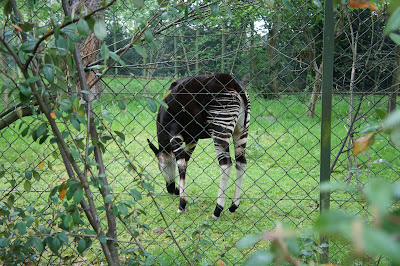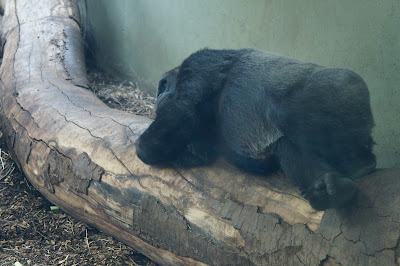Dublin Day 11: "Get outta here, birds. This is fancy bird town."
When we set off
for Dublin Zoo this morning, I had no idea what to expect. I am not a huge fan
of zoos back home. I’m not a huge fan of caging animals. I figured this zoo
would be like any other. Boy, was I wrong! Anyone who has the time to go see
the zoo while in Phoenix Park or in Dublin should definitely go check it out. I
saw the most animals I have ever seen in one visit, most performing natural
behaviors in natural habitats. That makes me a very happy animal lover and a
very happy visitor.
Instead of the
usual coach to get somewhere, we took the light rail system called LUAS
(pronounced like Lewis, which is what I thought it was called at first). The
stop was just a few blocks down from our hotel and the ticket was cheap—this is
the ideal way of getting around central Dublin on a budget. In fact, we planned
to take it to Kilmainham Geol (Jail) the next morning until we found out it
would be under construction that day.
Anyway, the ride
to Phoenix Park took about a half hour and the cars were full with people. The train jerked around a lot like a subway, but
worse because the train has to follow traffic rules. It’s crazy how crazy the
streets of Dublin are sometimes. After the bumpy ride, we arrived at Heuston
Station and then walked the remaining fifteen minutes up through Phoenix Park
and into the zoo.
Dublin Zoo is
the third oldest zoo in the world, after Vienna and London. It opened in 1830,
complete with horrible Victorian cages, elephant rides, and animals trained for
side shows. The idea was to subdue the animals so that people could physically
interact with them—probably not something they should be doing. One of the main
objectives of Dublin Zoo today is redoing all of the old caging and creating
natural habitats for the animals. The elephant and gorilla exhibits are the
best of these new exhibits so far, and we got to see both.
The zoo itself
is not huge—American zoos probably have more space with more animals. But the
variety of animals that were housed in natural habitats was astounding. We
learned a little more about that thanks to one of the elephant keepers named
Gerry. He gave us a lecture on conservation in zoos and how to use human care
as a positive rather than a negative. The humans are only there to assist, not
to control. The habitat should make sense to the anatomy and behaviors of the
animal, not the profit margin of the zoo. People will always come to see
animals, so why not have those animals be comfortable and active? That makes
the exhibit more interactive and also allows the animals to be happier,
healthier, and more cooperative?
Elephants, Gerry
assured us, are one of the most dangerous animals in the zoo. In the past, elephants
have even killed handlers who treated them poorly. Gerry believes their power
should be acknowledged and carefully respected. But their environment should
also help them to be as comfortable—and thus, as happy—as possible. Seven-foot
sand covers most of the exhibit, which can be used to sleep on and burrow into.
The keepers work each and every day to deliver food in exciting and innovative
ways, like planting brush into the sand, raining pellets down from above for
them to find, or hanging hay above their heads in nets to exercise their
trunks. There is even a remote feeding wall that not only requires mental
engagement to open (the holes are all different sizes for different trunks, so
no one elephant can steal all the food), but can be activated by a text from
the keeper. Gerry told us that last week, he fed the elephants from 30,000 feet
on a plane back from the US!
We learned a
little bit about their diet as well, and why that is important for keeping
health up. Overall, the message seemed to be that, as much mimicking of the
wild that can be done should be done.
The Dublin Zoo elephants sleep every night, and laying down each night. Their
babies are active and energetic all the time. The female elephants all gave
natural births, with the whole herd engaged in the process—just like in the
wild. All of the elephants are comfortable, well taken care of, and look
genuinely happy. It was awesome to see a program so concerned with the welfare
of the animals rather than the welfare of the zoo’s wallet.
After the
presentation, we walked over to the elephant habitat. It is a huge indoor area
connected to a series of outdoor spaces, which we needed to walk through to get
to the house. The elephants were all inside, munching on their food. But when
we came in, the keepers threw some peanuts around so that we could see the
elephants up close to the window.
But the
closeness wasn’t even the most amazing part. When Gerry started talking, the
matriarch elephant Dina heard his voice. She let out a literal scream like I
have never heard before. It sounded like a dinosaur noise from the movies. We
all jumped, but Gerry laughed. “She must be able to hear me through the glass,”
he said. “She just wants to say hello.” I was astonished. In all my time at
zoos, I have never heard an elephant—let alone any animal—be that vocal. They
usually just sit around and wait for the spectators to move on. Dina’s scream
is a testament to how well this zoo has taken care of these animals. If she
feels comfortable enough to make that much of a commotion, in a way that she
would make in the wild to see a favorite companion, they are doing something
right. That was the most amazing thing I have ever experienced in a zoo. Little
did I know that this small moment would only be the first of many more.
The elephant
house was great, but it was also crowded with our entire class. We made a pact
to come back later, when most people would be gone. We had already planned to
stay until close, so that would not be an issue. Exiting the building, we
headed down the African Trail and saw antelopes, an okapi (the closest living
relative to the giraffe), and some African dogs tearing away at a hunk of meat.
Again, I have never really seen an exhibit where the animals are given meat and
actively eating it like they would in the wild—together, and with excitement.
We then moved on
to see the gorillas, the other habitat that Gerry was proud of. Though all the
gorillas were indoors waiting to be fed, their outdoor enclosure looked just as
good as the elephants’. There were trees, little grassy patches, and lots of
room to move. I was very impressed. One of the gorillas even slept like me—on
her back, with her arms crossed over her chest and her feet tucked together. So
cute!
After that, we
looked in on some rhinos, zebras, giraffes, and ostriches. Again, these
habitats were big, open, and natural. The giraffes, zebras, and ostriches were
all in the same enclosure, but separated into herd like they would be in the
wild. They were obviously free to move between the groups, but many of them
chose to stay with their own species. This is exactly as it would be in the
wild, which was encouraging to see. There was even a baby giraffe roaming
around with his mama!
The next great
thing that happened was Cecelia the Sea Lion. That was not her real name—we
don’t even know if she was actually a girl. But based on how the other sea
lions were fighting violently and vocally (more natural sounds!) over the
singular rock in the habitat, we figured the one playing with the humans
through the glass would be the girl. Anyway, she played with us by swimming
back and forth between the two windows, racing us to get to the next one. She
would come up close to the glass and blow bubbles at our hands, or press her
nose into the glass to squish her nose. At one point, she even turned upside
down and hung there and then blew bubbles. It was the sweetest, most unexpected
interaction I have ever had at a zoo before. Her eyes were so kind that none of
us wanted to leave her.
A quick run
through the penguins (complete with mom and two eggs in a nest!) and flamingos
led us to the Red Panda habitat. I use the word habitat loosely. There was a
wooden fence of normal height, two large bamboo trees for their food and for
climbing, and then a little hut in the middle. That was it. They were
completely in the open air, no wire fencing or glass to shut them off from the
people watching them. I was astonished again. This would never happen in
America. But this way, we got to interact with them, watch them move, watch
them eat, watch them climb around and live life—all while only five feet away
from them. It was so cool to be that close and really understand an animal. I
never had a particular affinity toward red pandas until I got to see one move
around right in front of me. That is what zoos should be for: fostering
appreciation and respect for animals we would otherwise have no contact with.
Our trip wound down
after that. We visited the Reptile House, said hello to some monkeys and
sloths, and then stopped by the elephants again to say goodbye. Most of the
brush was knocked over and eaten, and the bull was now in his separate pen
doing some sort of backwards and forwards walking exercise. It was so strange,
yet oddly natural. He had some free time, so he was walking around in his own
space, doing some workouts. Around 6, we hopped on the LUAS and got back to the
hotel just a little late for dinner. Overall, I thought this was a very
successful day. Unexpectedly great, too.
I wish I would
have had that kind of zoo experience when I was younger. I always thought I
hated zoos because they are like traps for animals. But when I see animals as
happy as those in the Dublin Zoo, it gives me hope that zoos can also be a
place of learning, development, and engagement. With the help of great habitats
and healthy, naturally behaving animals, maybe the US can one day have programs
as prosperous as the one in Dublin.
♥





























































































No comments:
Post a Comment